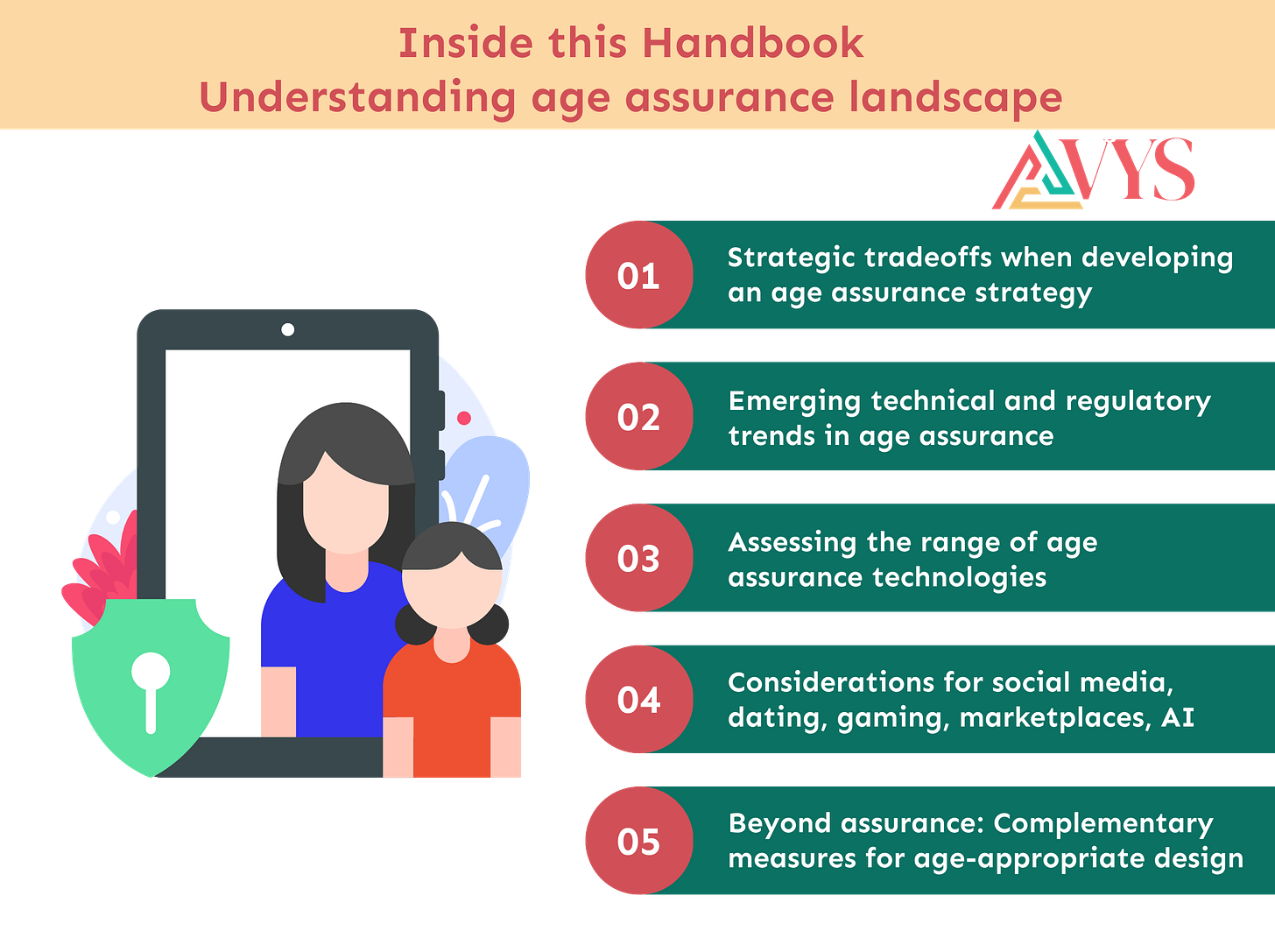The Age Assurance Implementation Handbook
A practical roadmap for teams to build out their age assurance strategy
In our March issue, we promised to share how we’re thinking about more effectively implementing age assurance at tech companies. Working closely with companies for a while now on their end-to-end age assurance strategy, we’ve been answering questions like what they need, key considerations for their vendor strategy, and how their internal teams can implement age assurance across the organization.
Yet as we’ve been in the weeds of this work, we gradually began to notice a number of misconceptions:
Age assurance is a one-time checkbox at signup
We need to send every single user through the age assurance process
The main goal of age assurance is to block underage users
Any form of age assurance (i.e. the cheapest) will do to tick the compliance box
Age assurance requires companies to retain large amounts of user data
In short, companies may sometimes treat age assurance as a purely technical challenge, overlooking the internal complexities that need to be resolved before launch. The result? Endless vendor interviews, product demos, and RFPs—only to hit a last-minute panic over issues like appeals prioritization, throwing the whole process off track.
So to address these misconceptions with a larger number of companies, we’ve developed the Age Assurance Implementation Handbook. Now available in our retail store, this guide will provide a practical roadmap for legal, product, and policy teams to build out their tailored age assurance strategy.
Why a handbook?
We’ve seen firsthand - whether when embedded in-house at tech platforms or helping them execute their strategy as advisors - how hard it is to implement age assurance well. It’s a cross-functional effort that spans product, engineering, legal, safety, and trust teams. Without a shared understanding, even the best-intentioned efforts often feel fragmented, timelines slip, and confusion ensues across the organization. We created this handbook to help teams get aligned, move faster, and build smarter.
We also wanted to provide a more affordable resource to companies that may not have the budget for full-scale implementation support, but still care deeply about getting this right. This guide should help most teams hit the ground running with their strategy, providing practical resources to help them move forward.
And finally, the age assurance landscape has gotten overwhelming. The pace of regulatory change, the patchwork of vendors each claiming to offer the most ideal solution, smaller inhouse teams that need to make their plans work, and the not-insignificant technical tradeoffs can quickly lead to confusion or missteps. We wanted to cut through the noise and help engineering, legal, safety, and trust teams make informed decisions from the start.
Inside the handbook
Part 1: Understanding age assurance landscape
The first half of this handbook explores a few strategic tradeoffs involved in age assurance - for example, between user friction and accuracy, data privacy and the need for external reporting, or the risks of over-reliance on a single method vs the potential for bias in certain technologies.
The next section helps companies stay ahead of evolving legal requirements with a concise overview of the current regulatory climate and political momentum driving age mandates - from growing fragmentation to stricter enforcement, to the rise of parental and educator influence in policymaking.
We then share the four core pillars we have developed for clients that we believe should inform every sound age assurance strategy, regardless of your company size or risk profile. Against those pillars, we evaluate the existing types of age assurance technologies, explaining how they work, and sharing our analysis of their strengths, limitations, and real-world applicability.
We also included two sections that some may consider tangential to the core issue, but we think are relevant: (a) specific considerations for sectors like social media, dating, gaming, marketplaces, and AI and (b) complementary measures to age assurance platforms may want to consider in building out their age-appropriate design strategy.
Part 2: Resources for product, legal, trust & safety teams
This is arguably the most hands-on section of this handbook and is meant to facilitate important conversations between cross-functional teams. Teams can download this guided framework to hit the ground running with their age assurance strategy. They can bring these questions and considerations to product, engineering, legal, or trust counterparts, building a strategy tailored to their product, user base, and stakeholder priorities. We provide criteria to vet age assurance vendors, designed for legal, product, and procurement teams navigating an increasingly crowded space. And finally, we give companies an integration & implementation checklist to align internal teams and streamline your deployment plan.
This is for every legal team, product manager, or trust and safety leader who has been asked “what should we do about age assurance?” who has then had to scramble to put together a strategy from scratch. With our guidance, checklists, vendor criteria, and best practices, we hope that companies will be able to hit the ground running with their age assurance strategy.



